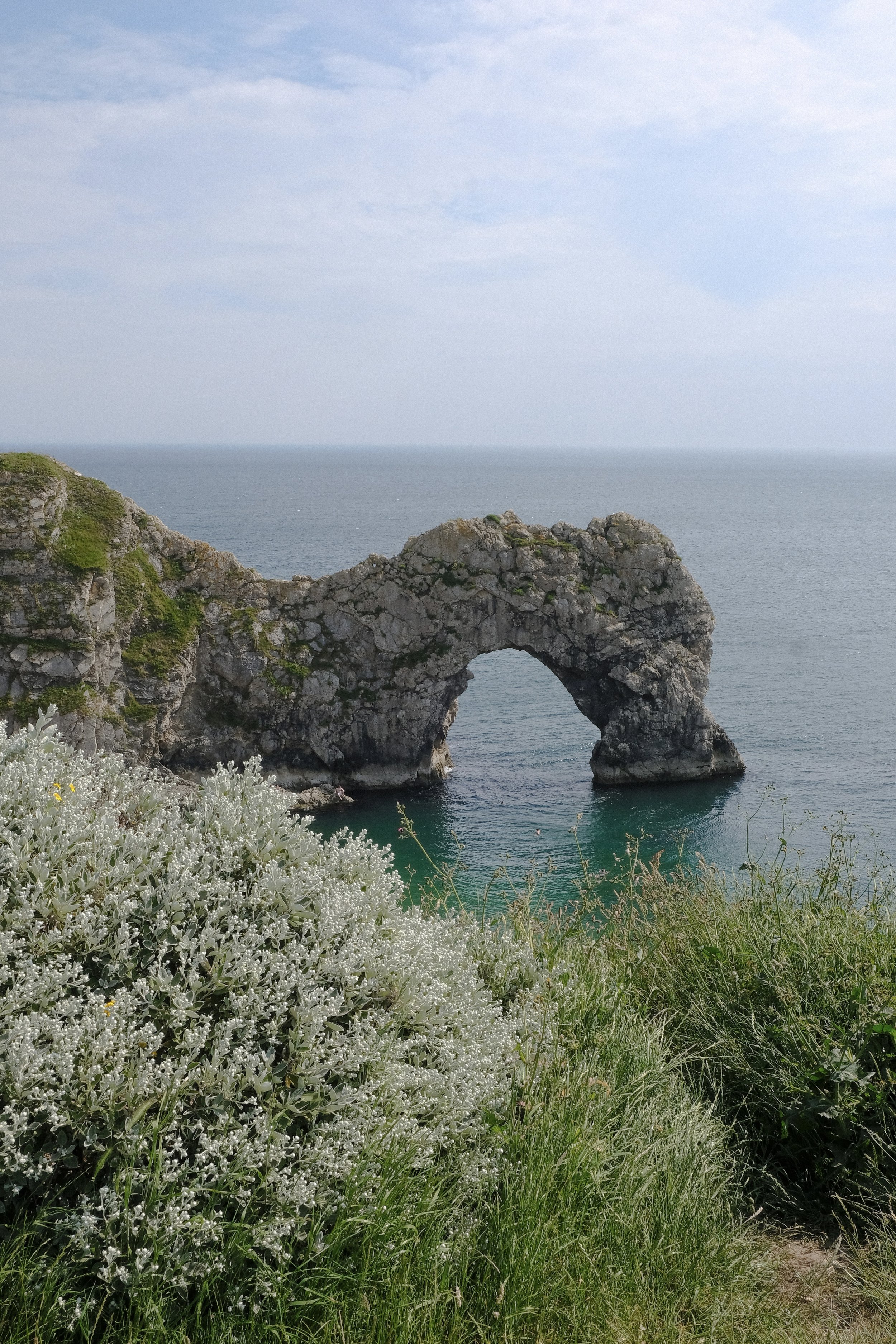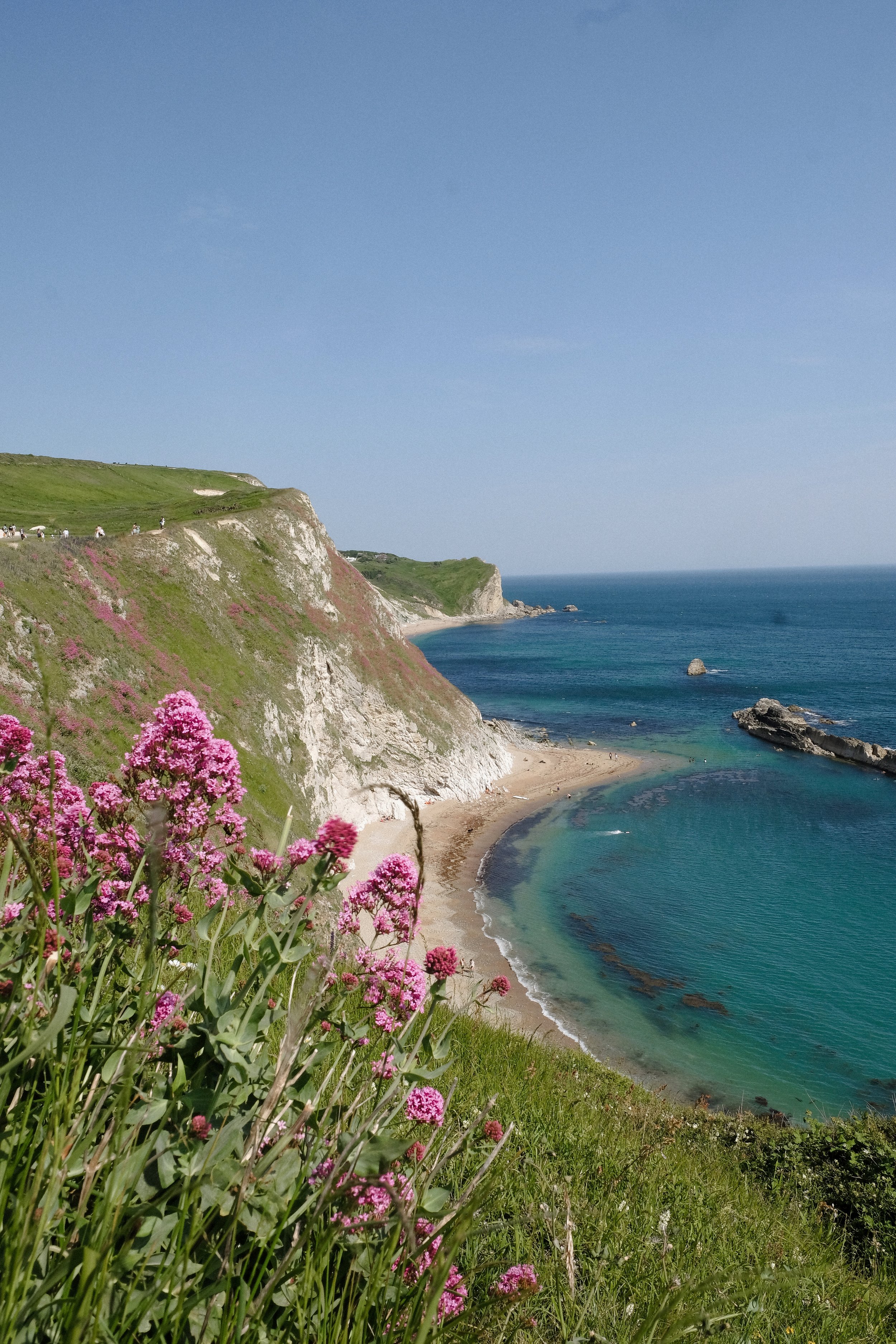A Weekend in Wareham
The Dorset Coast is a treasure of the British Isles and there was no better way to spend a warm weekend in June than exploring its coastline and local points of interest. This was an impromptu trip. Arran was already in Wareham working on BBC Springwatch, based at RSPB Arne, a fantastic nature reserve situated on Poole Harbour. Julie joined him for the weekend.
Arriving on a Thursday, Julie spent the evening alone in Wareham whilst Arran was working on the last show of the week. Whilst the company would have been lovely, it was a blissful evening in the Saxon walled town, one of the few remaining in England, in the perfect hazy light of dusk. Quaint cottages painted in an assortment of colours and a high-street bedecked with bunting and independent shops added to the town’s charm.
After a close call with a flock of black-headed gulls, a takeaway Margherita was enjoyed with a view of the graceful branches of weeping willows and the frothy flowers of cow parsley fluttering in the evening breeze.
On Friday we began our explorations. After a great breakfast at the fabulously named The Pink Goat, we headed to the majestic ruins of a thousand-year-old castle. Standing above the chocolate box village of the same name, Corfe Castle is a distinctive feature of the Isle of Purbeck peninsula. Founded by William the Conqueror after the Norman Conquest in 1066, its stone structure indicates it was of particularly high status since castles of the Medieval era were usually built from earth and timber. In 1635 the castle was bought by Sir John Bankes, Attorney General to King Charles I. During the English Civil War that broke out in 1642, the castle came under threat. Bankes’s wife, Lady Mary Bankes, was living in the castle with their children. She successfully defended the castle during two sieges, however, the castle was captured in 1645. The structure was deliberately slighted and this accounts for its current state. Today, however, it is still magnificent. Wildflowers grow from its crevices and peregrine falcons nest in the eaves.
We walked down to Corfe Castle railway station to see the view of the castle on the hill and spot the heritage steam trains that pass through. The station sits well in its picturesque surroundings. The perfectly moustached station guard and buttery coloured, green trimmed signal box look like they have dropped straight out of a Wes Anderson film. We spent some time in the small museum which is now also home to an old ticket printing press that is quite the sight. This was followed by a cold drink in the buffet car café. We were then lucky enough to see a steam train pull into the station. From here, you can ride a beautifully restored steam train and head to nearby Swanage for the afternoon. Since we already had plans for that afternoon, we decided to return on Sunday to do this journey. After Corfe we headed to the coast.
We drove to Lulworth Cove and our first stop was a much needed ice cream. Rhubarb and custard and honeycomb were our flavours of choice, and they provided a much needed sugar rush before we began our walk to Durdle Door.
The walk is straightforward, it’s one-mile-each-way and you cannot possibly get lost along the coastal path. However, in the afternoon sun, when the temperature was high (by England’s standards) and cloud cover was limited, it felt more like a professional hike, especially as the start of the route involves an incline. The views were worth it. The chalk headland jutted out, all the undulations of the striking white coastline were bright in the sun. We saw Bat’s Head, Man O’War and, the main event, Durdle Door.
We took the stairs down to the 10,000 year old limestone arch and enjoyed the late afternoon sun on the pebbled beach. To cool off, we paddled in the sea but it was a little too chilly for us so we enjoyed the late afternoon sun change the colour of the water and cliff face from the comfort of the shoreline. On our walk back we met the cliff’s resident cows, one of whom was particularly friendly and keen to pose for a portrait. We finished our day off with a lovely dinner at Lulworth Lodge Bistro.
The dusk light over Lulworth Cove was particularly beautiful. Small boats bobbed in the turquoise waters and beachgoers were catching the last rays of sun. The delightful Mill Pond and thatched cottages, framed by red valerian, were also quite exquisite in the evening glow.
We spent Saturday exploring the house and grounds of the National Trust’s Kingston Lacy. Corfe Castle and Kingston Lacy – two (distinctly) different palaces – are, in fact, united by one family. The Bankes are the centre of both. After the restoration of the monarchy in 1660, the family regained their properties. Rather than rebuild or replace the ruined Corfe Castle they decided to build a new house at Kingston Lacy.
The family were not traditional aristocratic nobility, they were landed gentry who became one of the richest families in England, funded mainly by the family's monopoly of graphite production that was used in canon balls. Kingston Lacy is a testament to their taste and wealth. William John Bankes, the home’s inherited owner from 1834, set about making changes to the renovations his father had made in the late eighteenth-century. William John Bankes, however, never fully brought his vision to Kingston Lacy whilst living there. In 1841 he went into voluntary exile in Venice after he was charged for the second time with homosexuality, illegal at the time. Yet, Kingston Lacy continued to thrive thanks to Bankes’s penchant for collecting. He sent back art, marble carvings and furniture to his siblings back in Dorset with detailed instructions on how each object should be displayed and curated.
The interior of Kingston Lacy is absolutely brimming with treasures and big names from the world of art and design, all of which is situated within an interior inspired by an Italian palazzo.. Thus, despite not being nobility, their Wimborne Minster home would fool you otherwise. The names of Peter Paul Rubens, Van Dyck, the circle of Raphael, Titian, Jan Brueghel the Younger, Velázquez, Tintoretto, Sir Peter Lely and George Romney adorn the walls. The most famous Velázquez – Las Meninas – is also part of Kingston Lacy’s story. Whilst Madrid’s Prado Museum houses the original, the version here, attributed to Velázquez’s son-in-law, demonstrates William Bankes’s eye for Spanish masterpieces. It is situated in the suitably named Spanish Room, whose walls are lined with finely tooled leather in floral patterns. Moreover, each door panel represents one month of the year and there are quirky, witty additions to help you work out which month is being described. The top panels, full of colour, represent the seasons of spring and summer, and the dark, monochromatic panels below represent autumn and winter. Saint Valentine features for February and December is marked by a candle snuffer over the sun. A lapis lazuli painted tunic by Velázquez, oak double doors acquired from the Vatican, an organ designed by the same company that conceived the one in Buckingham Palace and an impressive Ancient Egyptian collection are a few other interesting features of the rich and eclectic collection at Kingston Lacy that you must look out for when you visit.
After Arran had a short nap in one of the deck chairs decorating the lawns of the formal gardens, he perked up at the thought of cheese in our near future. So we finished our visit exploring the beautiful Japanese and kitchen gardens of the estate before heading to Renoufs in Wimborne for a delicious platter of cheeses and meats and a nice glass of Provençal rosé.
On Sunday we returned to Corfe Castle station to hop on a steam train to Swanage. You can check out the timetable and book tickets on their website. A piece of advice would be to hop on the train that is going to Norden (this is only one stop), watch the train turn around and thus, begin your journey to Swanage from here. It was a fantastic experience, coursing through the Dorset countryside on reupholstered moquette benches. We arrived in Swanage at midday and headed to Love Cake Café for lunch. Their homemade cakes were something else.
We had not planned to stay in Swanage for more than an hour, but realising there was a lot we could do we decided to stay and explore. We headed to Durlston Country Park and National Nature Reserve for a walk along the coastal path. We walked all the way to Anvil Point Lighthouse, passing Durlston Castle, Tilly Whim Caves and a bazaar (yes, that’s the collective noun) of guillemots. The weather had turned a bit, which was rather welcomed after the high temperatures the previous days, but everything looked a quite atmospheric in the summer drizzle. We returned to Corfe on the last steam train of the day to enjoy our final evening together in Wareham.
We experienced all the joys of the Jurassic Coast during this June weekend and look forward to returning soon…maybe next year for Springwatch 2024.


































































